Intellectual Structure in Supply Chain Risk Management from 2000 to 2022: A Review Based on Text Mining Approach
Abstract
:1. Introduction
2. Research Design
2.1. Tools and Technology
2.1.1. CiteSpace
2.1.2. Latent Dirichlet Allocation
2.2. Data Source
3. Bibliometric Analysis Based on CiteSpace
3.1. Co-Occurring Terms and Co-Occurring Keywords Analysis
3.2. Cooperation Analysis of Authors, Institutions, and Countries
4. Cited References Analysis
4.1. Co-Cited Reference Analysis
4.2. Co-Cited Author Analysis
4.3. Co-Cited Journal Analysis
5. Topics Evolution
6. Conclusions and Future Work
6.1. Conclusions
6.2. Managerial Implication
6.3. Future Work
Author Contributions
Funding
Data Availability Statement
Conflicts of Interest
References
- Lawrence, J.M.; Hossain, N.U.I.; Jaradat, R.; Hamilton, M. Leveraging a Bayesian network approach to model and analyze supplier vulnerability to severe weather risk: A case study of the US pharmaceutical supply chain following Hurricane Maria. Int. J. Disaster Risk Reduct. 2020, 49, 101607. [Google Scholar] [CrossRef] [PubMed]
- Tang, O.; Musa, S.N. Identifying risk issues and research advancements in supply chain risk management. Int. J. Prod. Econ. 2011, 133, 25–34. [Google Scholar] [CrossRef] [Green Version]
- Sharma, S.K.; Srivastava, P.R.; Kumar, A.; Jindal, A.; Gupta, S. Supply chain vulnerability assessment for manufacturing industry. Ann. Oper. Res. 2021, 6, 1–31. [Google Scholar] [CrossRef]
- Butt, A.S. Strategies to mitigate the impact of COVID-19 on supply chain disruptions: A multiple case analysis of buyers and distributors. Int. J. Logist. Manag. 2021, 3, 1–19. [Google Scholar] [CrossRef]
- Yang, J.; Xie, H.; Yu, G.; Liu, M. Antecedents and consequences of supply chain risk management capabilities: An investigation in the post-coronavirus crisis. Int. J. Prod. Res. 2021, 59, 1573–1585. [Google Scholar] [CrossRef]
- Pournader, M.; Kach, A.; Talluri, S. A review of the existing and emerging topics in the supply chain risk management literature. Decis. Sci. 2020, 51, 867–919. [Google Scholar] [CrossRef] [PubMed]
- Colicchia, C.; Strozzi, F. Supply chain risk management: A new methodology for a systematic literature review. Supply Chain Manag. 2012, 17, 403–418. [Google Scholar] [CrossRef]
- Hamdi, F.; Ghorbel, A.; Masmoudi, F.; Dupont, L. Optimization of a supply portfolio in the context of supply chain risk management: Literature review. J. Intell. Manuf. 2018, 29, 763–788. [Google Scholar] [CrossRef]
- Ho, W.; Zheng, T.; Yildiz, H.; Talluri, S. Supply chain risk management: A literature review. Int. J. Prod. Res. 2015, 53, 5031–5069. [Google Scholar] [CrossRef]
- Donthu, N.; Kumar, S.; Mukherjee, D.; Pandey, N.; Lim, W.M. How to conduct a bibliometric analysis: An overview and guidelines. J. Bus. Res. 2021, 133, 285–296. [Google Scholar] [CrossRef]
- Dahesh, M.B.; Tabarsa, G.; Zandieh, M.; Hamidizadeh, M. Reviewing the intellectual structure and evolution of the innovation systems approach: A social network analysis. Technol. Soc. 2020, 63, 101399. [Google Scholar] [CrossRef]
- Dionisio, M. The evolution of social entrepreneurship research: A bibliometric analysis. Soc. Enterp. J. 2019, 15, 22–45. [Google Scholar] [CrossRef]
- Ferreira, F.A.; Santos, S.P. Two decades on the MACBETH approach: A bibliometric analysis. Ann. Oper. Res. 2021, 296, 901–925. [Google Scholar] [CrossRef]
- Linnenluecke, M.K.; Marrone, M.; Singh, A.K. Conducting systematic literature reviews and bibliometric analyses. Aust. J. Manag. 2020, 45, 175–194. [Google Scholar] [CrossRef]
- Li, X.; Lei, L. A bibliometric analysis of topic modelling studies (2000–2017). J. Inf. Sci. 2021, 47, 161–175. [Google Scholar] [CrossRef]
- Lopes, J.M.; Sousa, A.; Calçada, E.; Oliveira, J. A citation and co-citation bibliometric analysis of omnichannel marketing research. Manag. Rev. Q. 2021, 72, 1017–1050. [Google Scholar] [CrossRef]
- Hota, P.K.; Subramanian, B.; Narayanamurthy, G. Mapping the intellectual structure of social entrepreneurship research: A citation/co-citation analysis. J. Bus. Ethics 2020, 166, 89–114. [Google Scholar] [CrossRef]
- Khanra, S.; Dhir, A.; Kaur, P.; Mäntymäki, M. Bibliometric analysis and literature review of ecotourism: Toward sustainable development. Tour. Manag. Perspect. 2021, 37, 100777. [Google Scholar] [CrossRef]
- Zhao, L.; Yang, M.M.; Wang, Z.; Michelson, G. Trends in the dynamic evolution of corporate social responsibility and leadership: A literature review and bibliometric analysis. J. Bus. Ethics 2022, 1, 1–23. [Google Scholar] [CrossRef]
- Behrend, J.; Eulerich, M. The evolution of internal audit research: A bibliometric analysis of published documents (1926–2016). Account. Hist. Rev. 2019, 29, 103–139. [Google Scholar] [CrossRef]
- Albort-Morant, G.; Leal-Rodríguez, A.L.; Fernández-Rodríguez, V.; Ariza-Montes, A. Assessing the origins, evolution and prospects of the literature on dynamic capabilities: A bibliometric analysis. Eur. Res. Manag. Bus. Econ. 2018, 24, 42–52. [Google Scholar] [CrossRef]
- Wang, L.; Cheng, Y.; Wang, Z. Risk management in sustainable supply chain: A knowledge map towards intellectual structure, logic diagram, and conceptual model. Environ. Sci. Pollut. Res. 2022, 29, 66041–66067. [Google Scholar] [CrossRef] [PubMed]
- Xu, S.; Zhang, X.; Feng, L.; Yang, W. Disruption risks in supply chain management: A literature review based on bibliometric analysis. Int. J. Prod. Res. 2020, 58, 3508–3526. [Google Scholar] [CrossRef]
- Hallinger, P. Analyzing the intellectual structure of the Knowledge base on managing for sustainability, 1982–2019: A meta-analysis. Sustain. Dev. 2020, 28, 1493–1506. [Google Scholar] [CrossRef]
- Chen, C. Science Mapping: A Systematic Review of the Literature. J. Data Inf. Sci. 2017, 2, 1–40. [Google Scholar] [CrossRef] [Green Version]
- Blei, D.M.; Ng, A.Y.; Jordan, M.I. Latent dirichlet allocation. J. Mach. Learn. Res. 2003, 3, 993–1022. [Google Scholar]
- Köseoglu, M.A.; Sehitoglu, Y.; Craft, J. Academic foundations of hospitality management research with an emerging country focus: A citation and co-citation analysis. Int. J. Hosp. Manag. 2015, 45, 130–144. [Google Scholar] [CrossRef]
- Pilkington, A.; Meredith, J. The evolution of the intellectual structure of operations management—1980–2006: A citation/co-citation analysis. J. Oper. Manag. 2009, 27, 185–202. [Google Scholar] [CrossRef]
- Ji, L.; Wang, Y.; Shi, B.; Zhang, D.; Wang, Z.; Yan, J. Microsoft concept graph: Mining semantic concepts for short text understanding. Data Intell. 2019, 1, 238–270. [Google Scholar] [CrossRef]
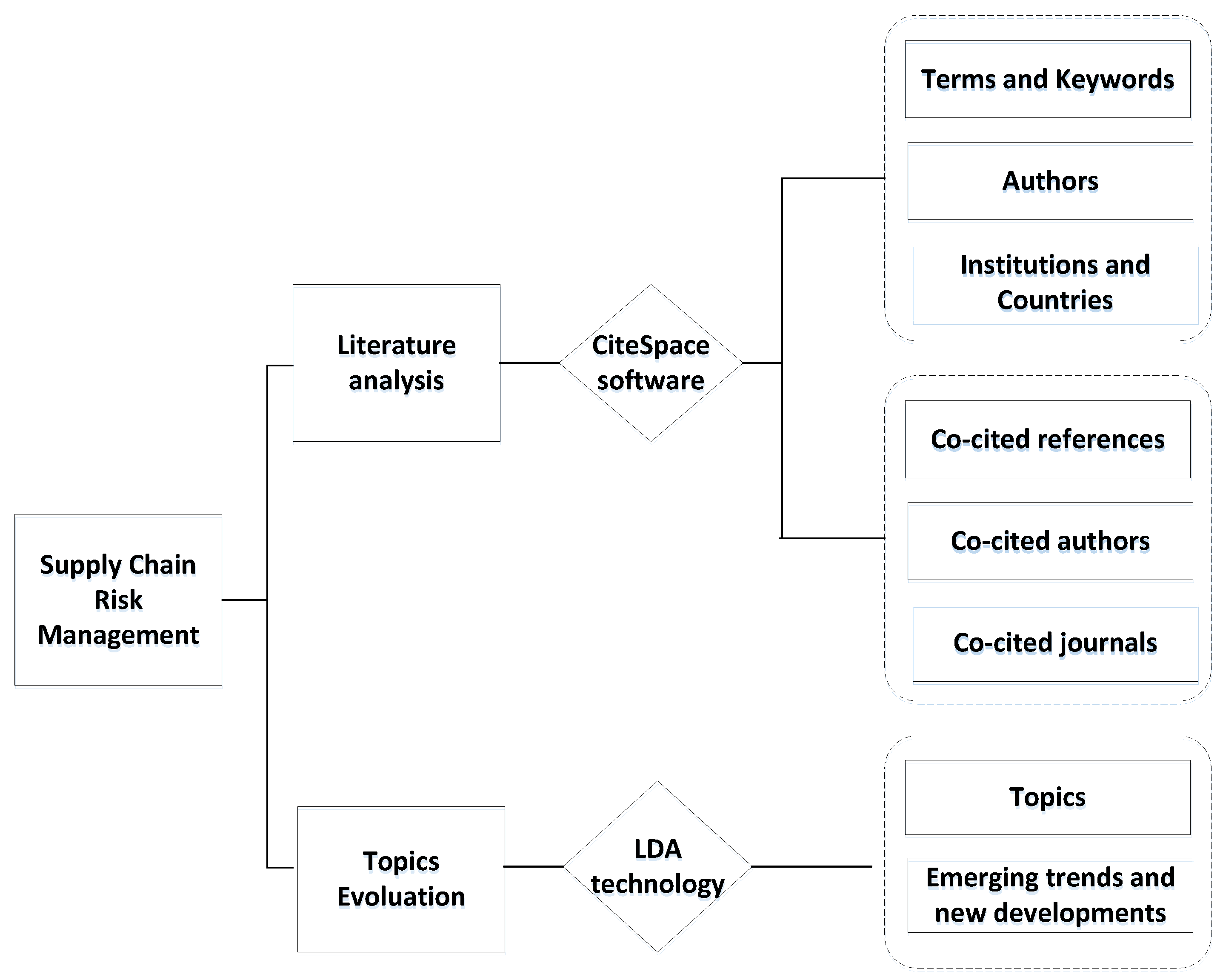

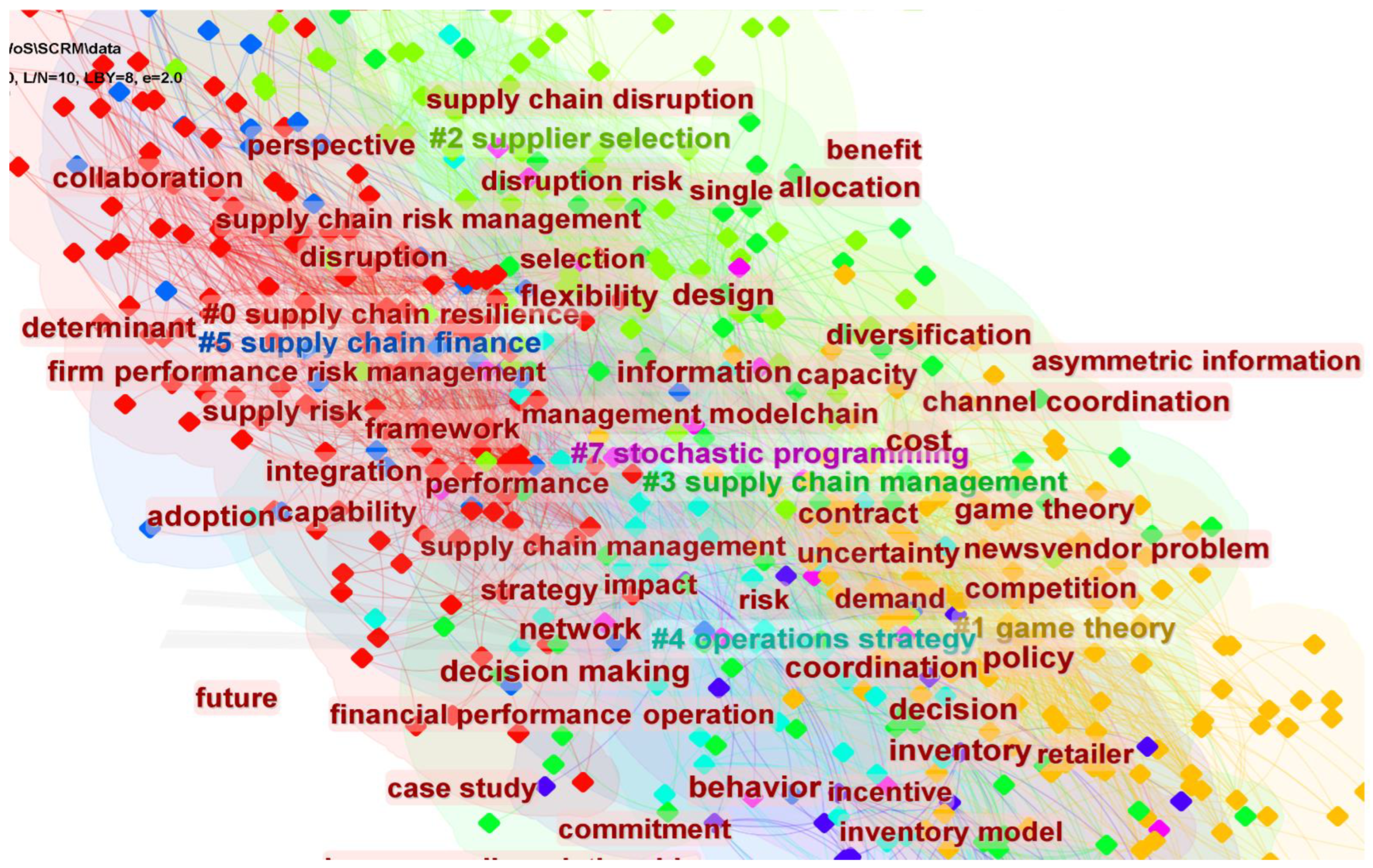
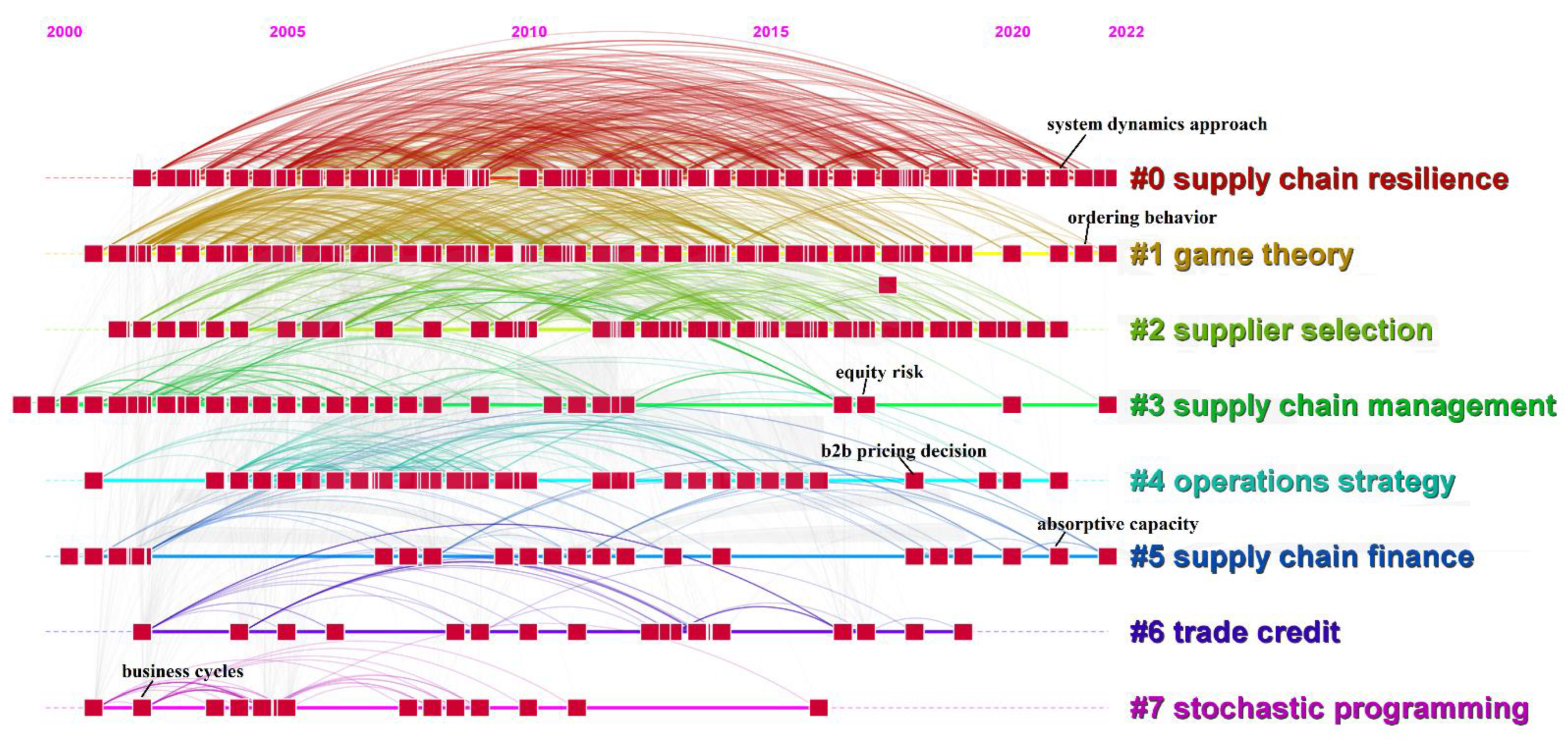

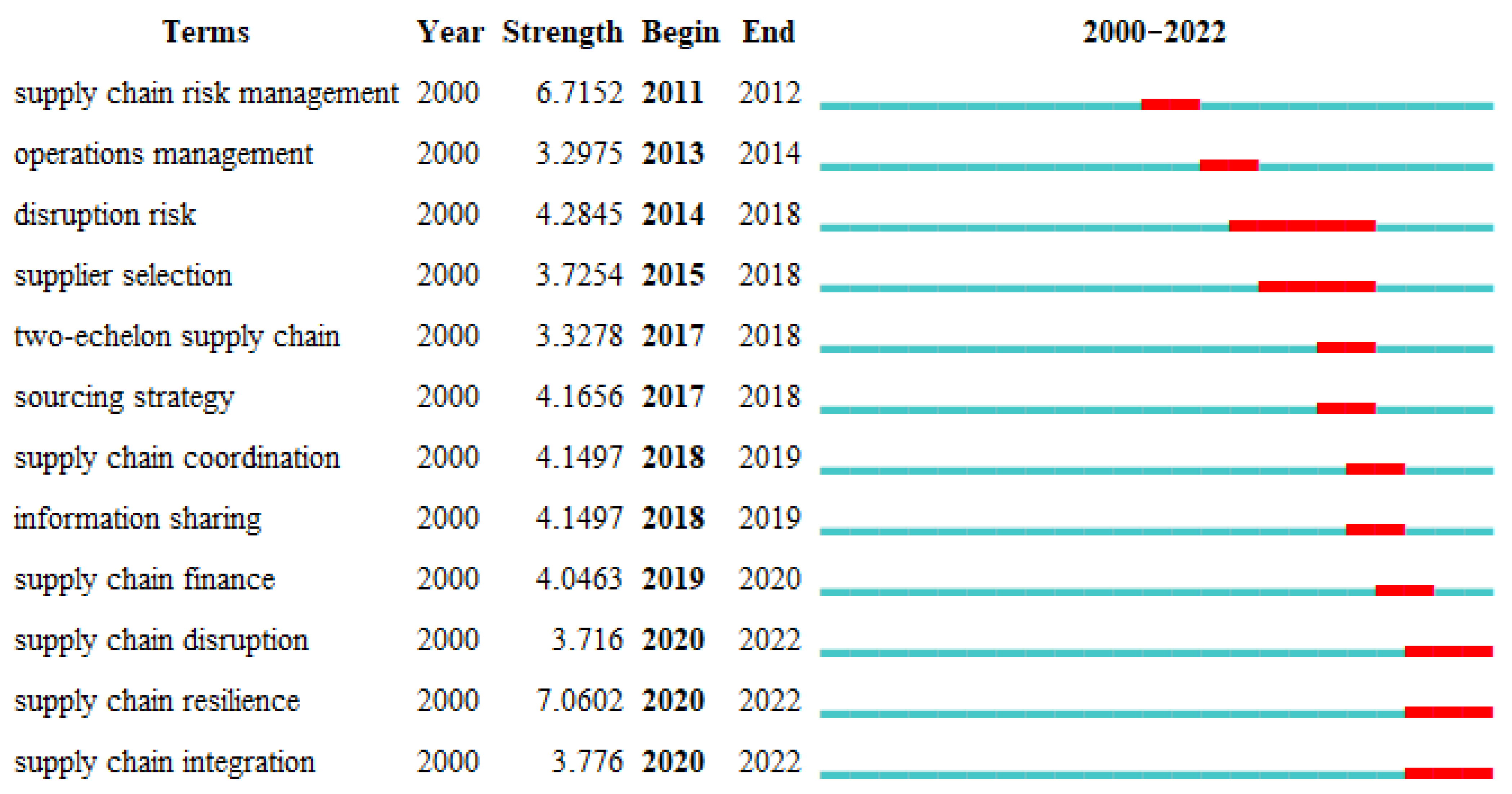

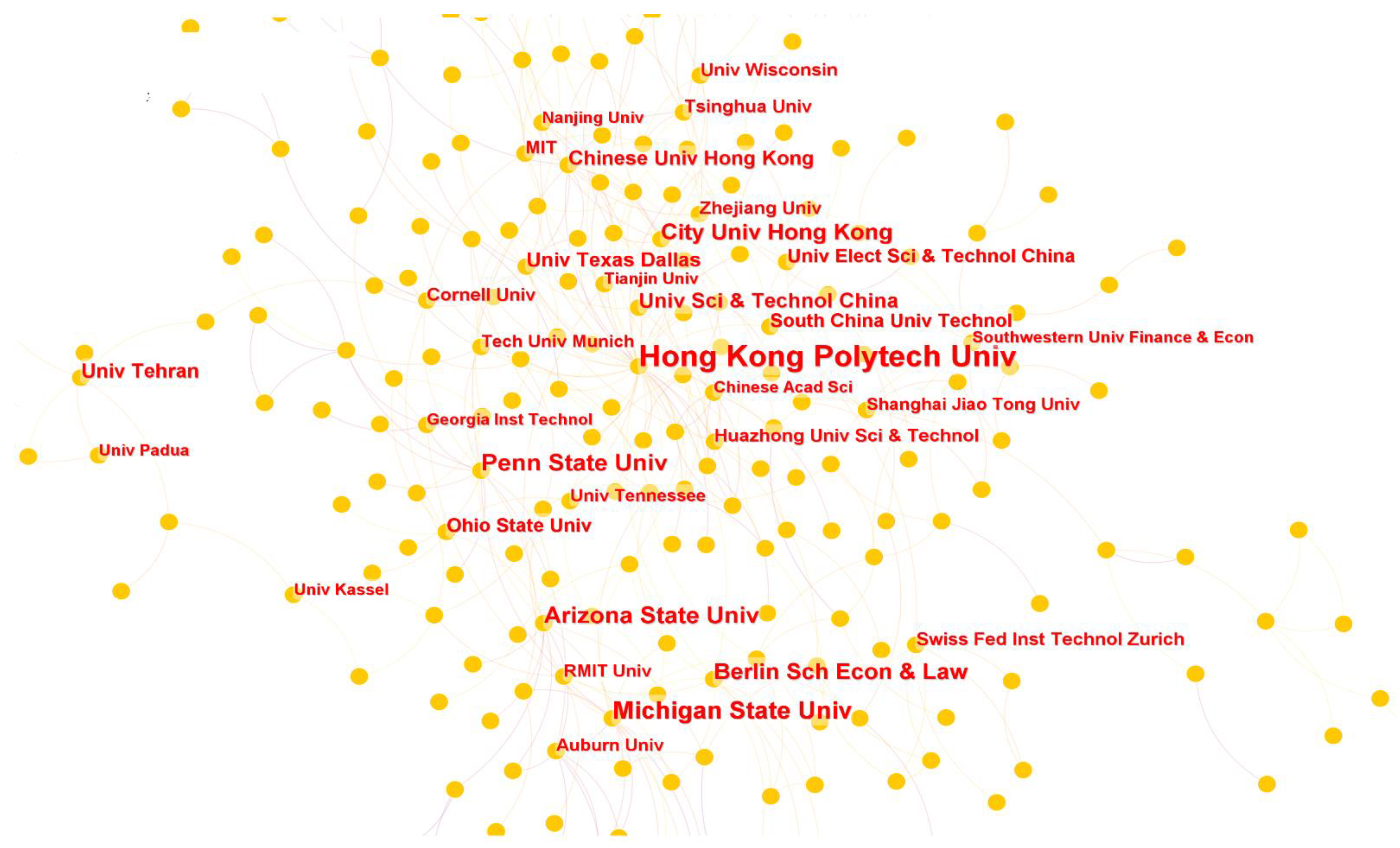
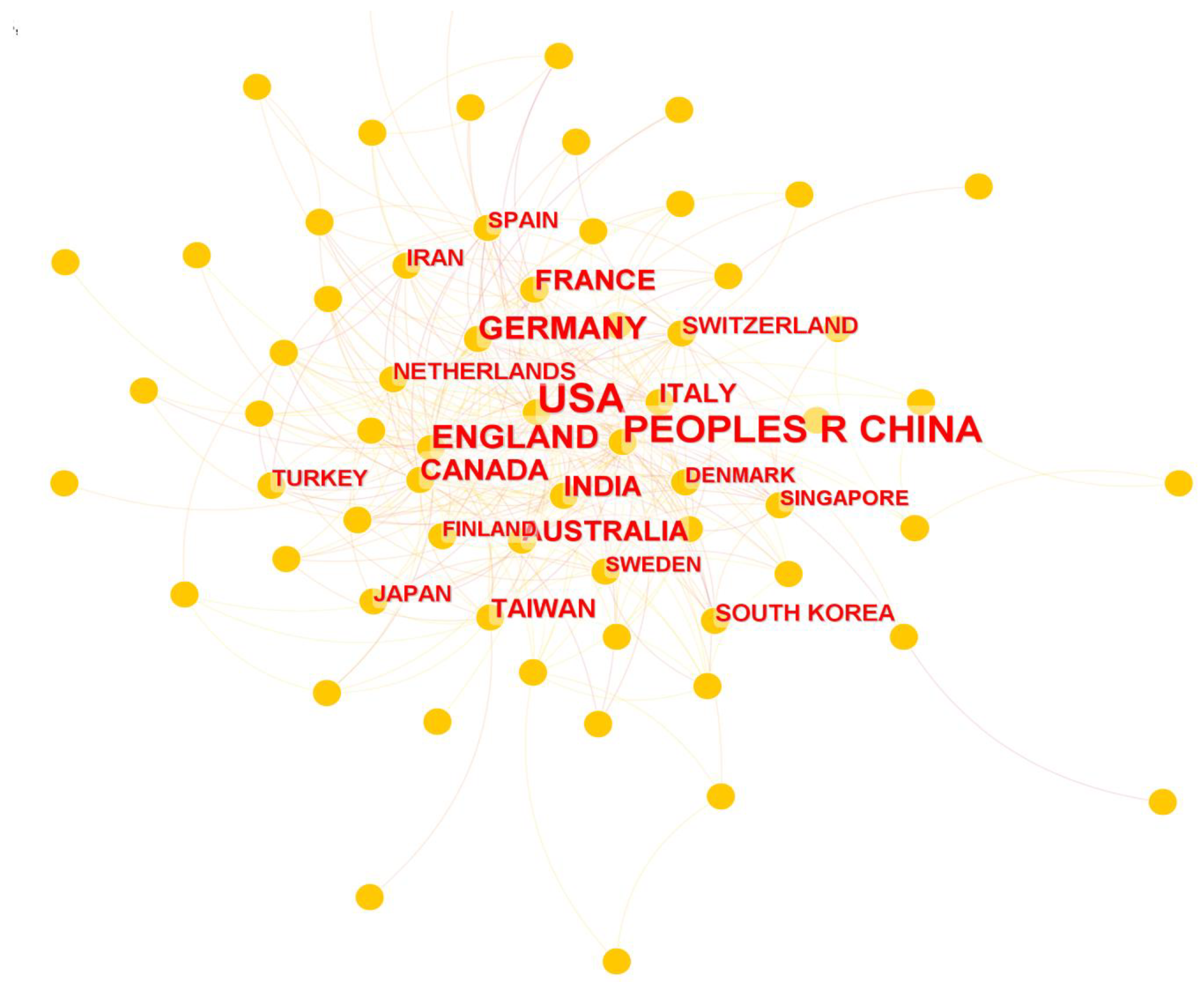
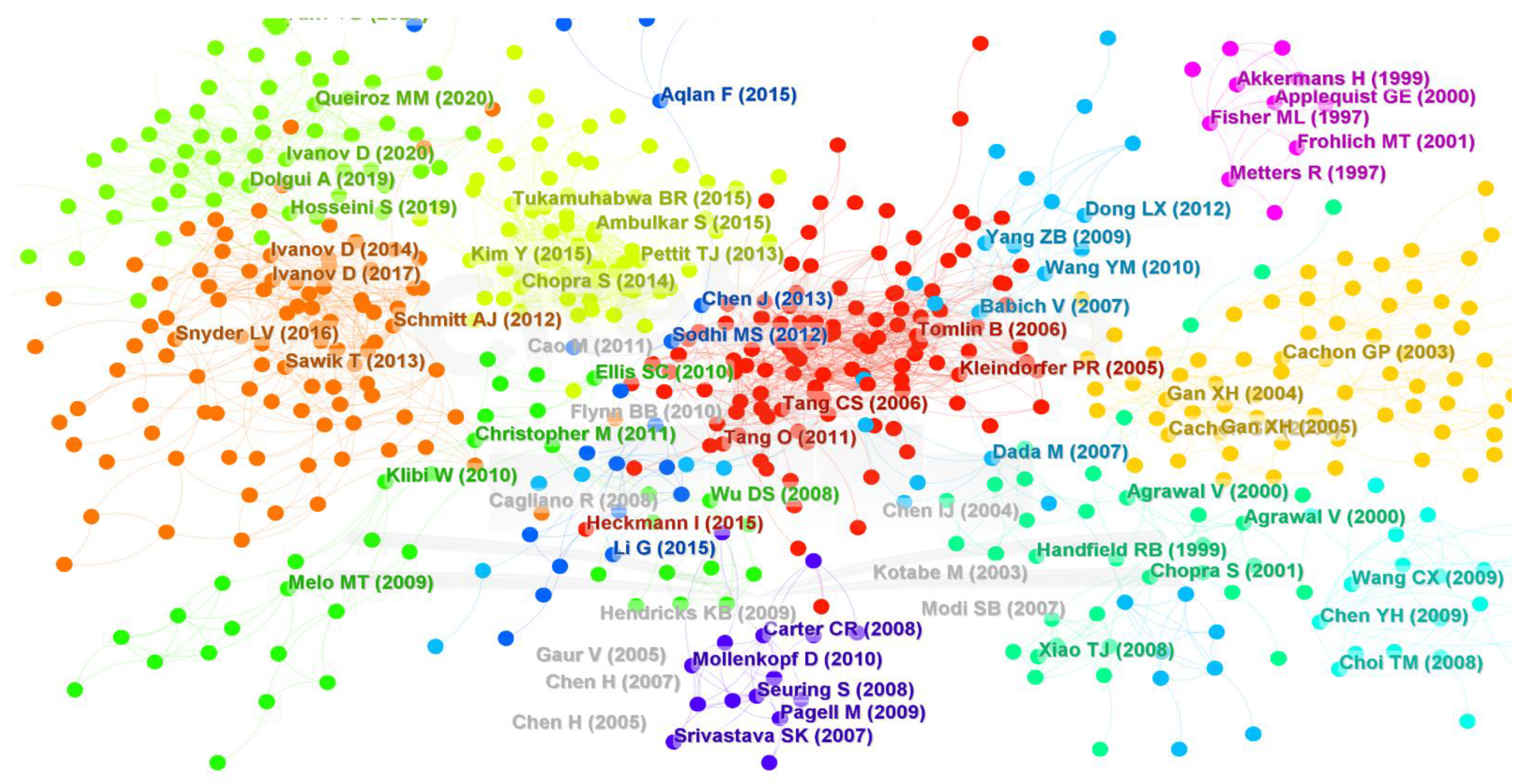

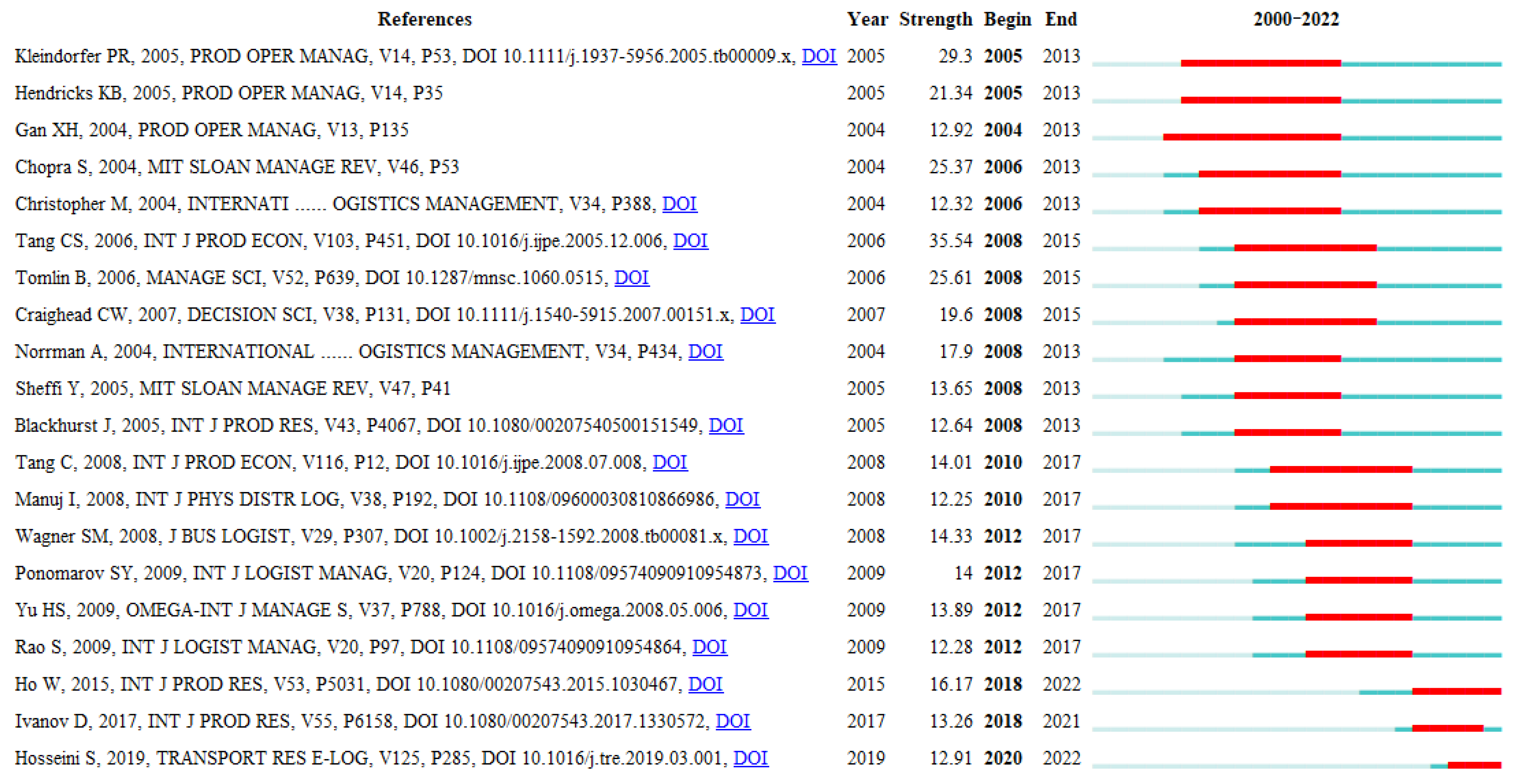
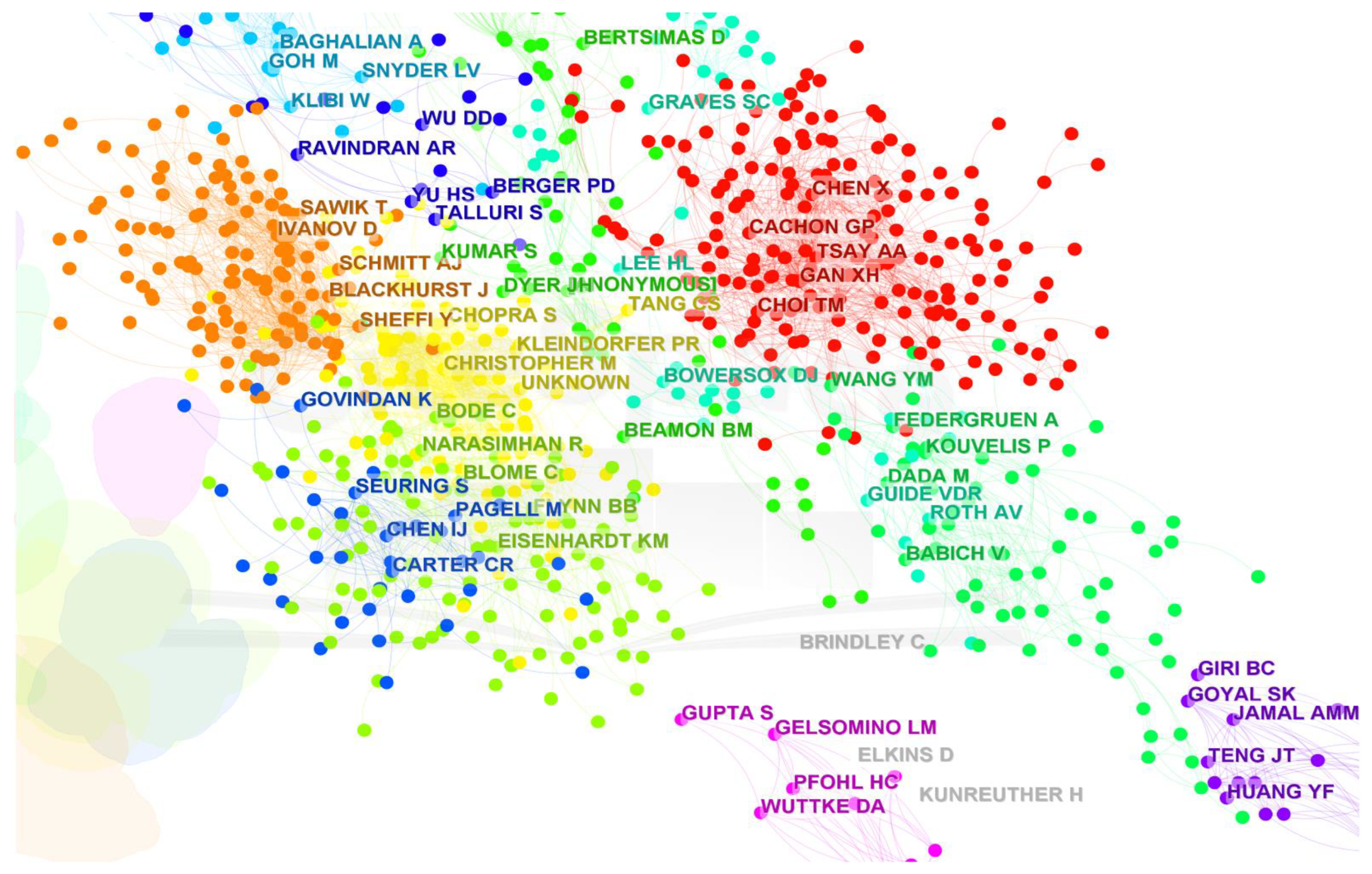

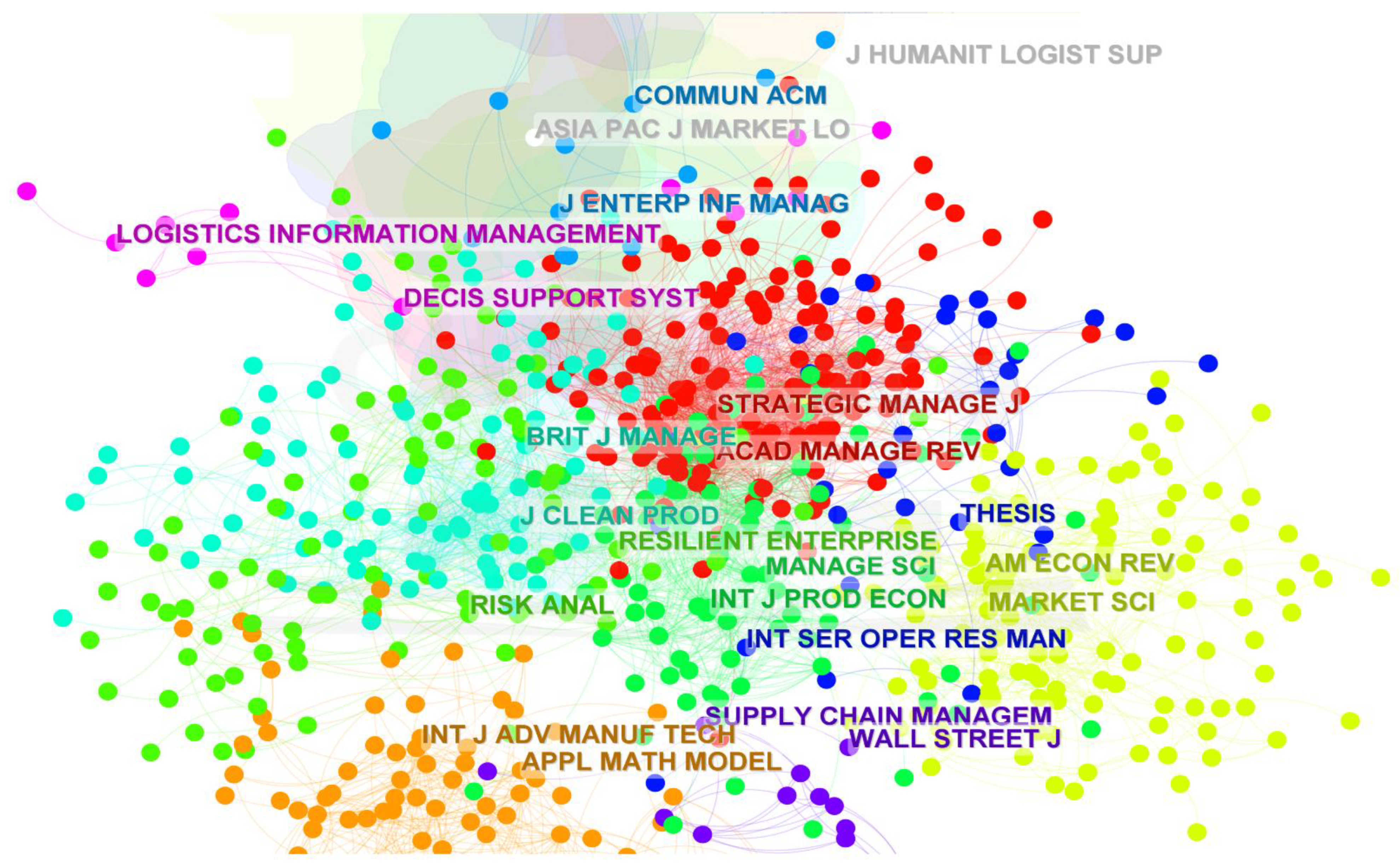
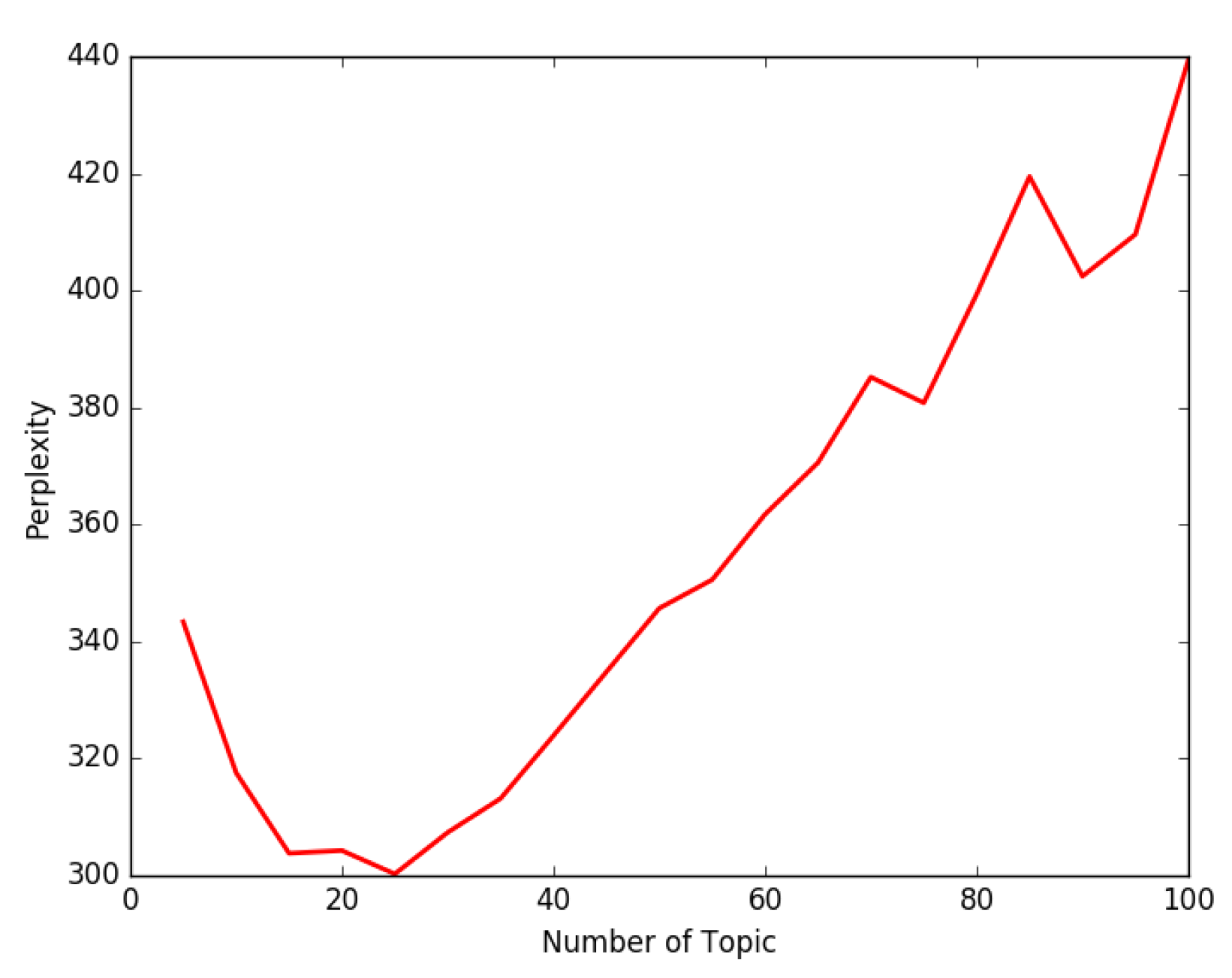
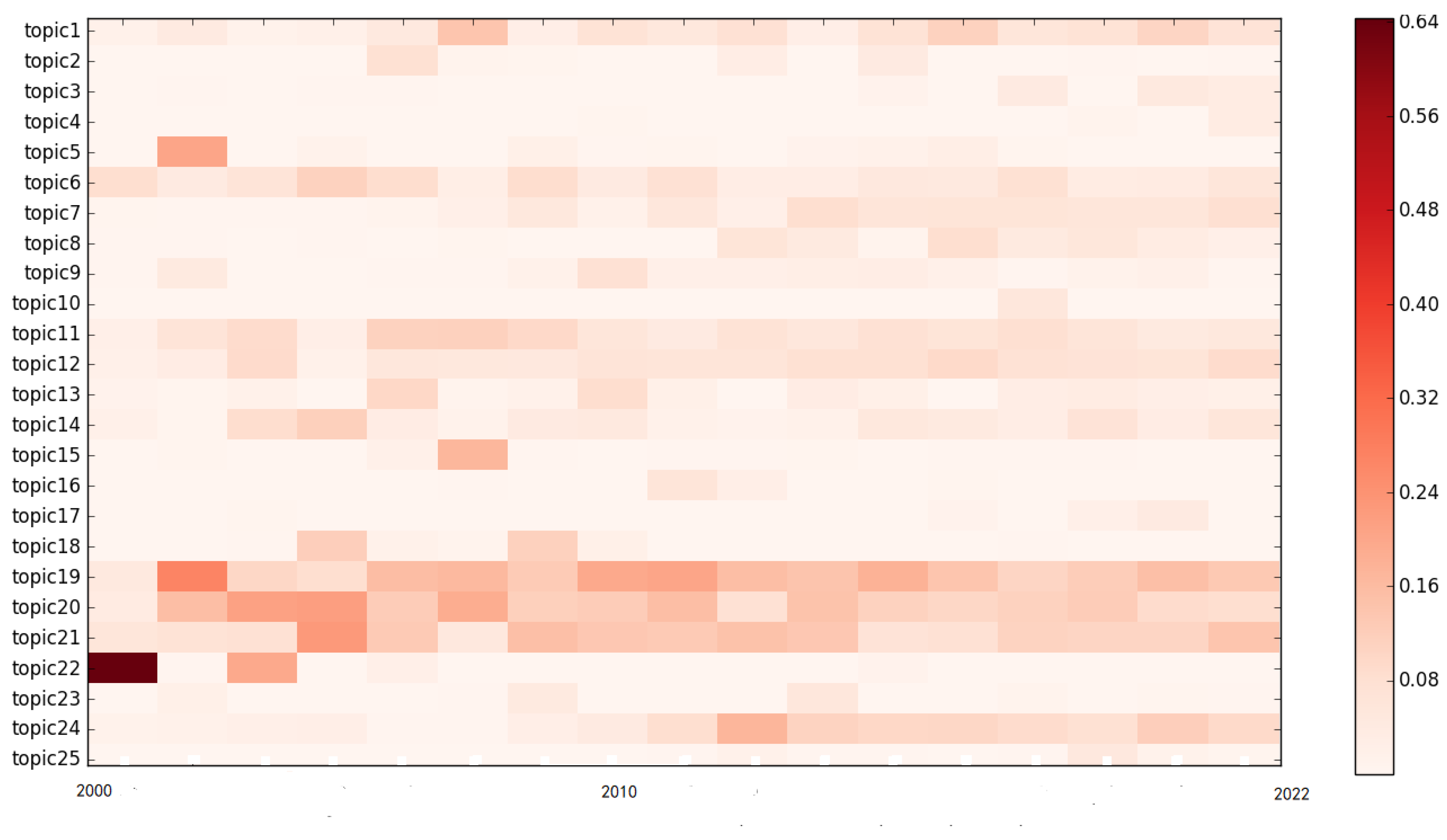
| Journal | Quantity | Proportion |
|---|---|---|
| International Journal of Production Economics | 423 | 23.31% |
| International Journal of Production Research | 414 | 22.72% |
| European Journal of Operational Research | 229 | 12.57% |
| Supply Chain Management: An International Journal | 162 | 8.90% |
| Production and Operations Management | 145 | 7.96% |
| International Journal of Logistics Management | 107 | 5.87% |
| Omega | 83 | 4.56% |
| Journal of Operations Management | 67 | 3.68% |
| Decision Sciences | 55 | 3.02% |
| Journal of the Operational Research Society | 49 | 2.69% |
| Management Science | 33 | 1.81% |
| Planning and Control | 22 | 1.21% |
| Interfaces | 11 | 0.60% |
| Operations Research | 7 | 0.38% |
| Harvard Business Review | 5 | 0.27% |
| California Management Review | 5 | 0.27% |
| MIT Sloan Management Review | 5 | 0.27% |
| Cluster | Size | Silhouette | Label (LLR) | Label (LSI) |
|---|---|---|---|---|
| #0 | 61 | 0.973 | supply chain (86.02, 1.0 × 10−4); empirical investigation (45.94, 1.0 × 10−4); financial flow (39.61, 1.0 × 10−4); financial supply chain management (39.61, 1.0 × 10−4); dominant retailer (37.51, 1.0 × 10−4); | supply chain; inventory risk; advance-purchase discount contracts; allocation; lead time variability; |
| #1 | 16 | 0.990 | supply chain resilience (108.17, 1.0 × 10−4); risk propagation (46.09, 1.0 × 10−4); network characteristics (46.09, 1.0 × 10−4); artificial intelligence (40.91, 1.0 × 10−4); agriculture supply chain perspective (40.91, 1.0 × 10−4); | supply chain resilience; adaptive cycle approach; insurance; role; behavioral experiment; |
| #2 | 15 | 0.956 | behavioral investigation (74.02, 1.0 × 10−4); operations management (69, 1.0 × 10−4); supply chain risk management (69, 1.0 × 10−4); supply chain integration (62.99, 1.0 × 10−4); empirical analysis (54.01, 1.0 × 10−4); | behavioral investigation; supply chain; transshipments; literature; review; |
| #3 | 12 | 0.995 | supply chain management (169.31, 1.0 × 10−4); literature review (68.84, 1.0 × 10−4); COVID−19 outbreak (59.52, 1.0 × 10−4); blockchain adoption (54.88, 1.0 × 10−4); quality inspection v (45.63, 1.0 × 10−4); | supply chain management; theoretic model; blockchain; smart contracts; game; |
| #4 | 12 | 0.944 | ripple effect (93.42, 1.0 × 10−4); systematic literature review (78.24, 1.0 × 10−4); conceptual framework (47.56, 1.0 × 10−4); synchromodal freight transport (43.45, 1.0 × 10−4); system dynamics approach (43.45, 1.0 × 10−4); | supply risk; systematic literature review; digging; price risks; agent-based simulation study; |
| #5 | 12 | 0.986 | demand uncertainty (153.08, 1.0 × 10−4); sourcing strategies (68.16, 1.0 × 10−4); agglomeration economies (45.19, 1.0 × 10−4); retail competition (45.19, 1.0 × 10−4); capacity risk (45.19, 1.0 × 10−4); | demand uncertainty; coordination; consumer return; supply chain; air shipment; |
| #6 | 12 | 0.957 | risk management (129.92, 1.0 × 10−4); supply network (75.97, 1.0 × 10−4); exploratory study (47.14, 1.0 × 10−4); automotive supply chain (47.14, 1.0 × 10−4); risk assessment (37.63, 1.0 × 10−4); | risk management; closed loop supply chain; kanban system; risk assessment; strategic cooperation; |
| #7 | 7 | 0.997 | assembly system (41.22, 1.0 × 10−4); channel coordination (32.83, 1.0 × 10−4); advance demand information (32.83, 1.0 × 10−4); replenishment strategies (32.83, 1.0 × 10−4); distribution system (32.83, 1.0 × 10−4); | assembly system; hybrid push-pull contract; delivery quantity; processing time; facing uncertain demand; |
| #8 | 6 | 0.997 | integrative supply chain strategy (12.44, 1.0 × 10−4); indirect relationship (12.44, 1.0 × 10−4); financial performance (12.44, 1.0 × 10−4); customer service (12.44, 1.0 × 10−4); supply chain (0.67, 1.0 × 10−4); | integrative supply chain strategy; customer service; financial performance: indirect relationships; supply chain; |
| #9 | 6 | 0.993 | deteriorating item (139.32, 1.0 × 10−4); expiration date (47.15, 1.0 × 10−4); two-level trade credit financing (26.75, 1.0 × 10−4); lot size (26.75, 1.0 × 10−4); partial trade credit (20.01, 1.0 × 10−4); | deteriorating items; optimal credit period; supply chain; cycle time; partial trade credit; |
| Term | Centrality |
|---|---|
| supply chain | 0.18 |
| supply chain resilience | 0.17 |
| demand uncertainty | 0.16 |
| risk management | 0.14 |
| supply chain management | 0.13 |
| disruption risks | 0.13 |
| empirical analysis | 0.11 |
| ripple effect | 0.1 |
| supply chain disruptions | 0.09 |
| Freq | Centrality | Keyword | Cluster ID |
|---|---|---|---|
| 193 | 0.18 | supply chain | #0 |
| 31 | 0.13 | supply chain resilience | #2 |
| 27 | 0.13 | supply chain risk management | #0 |
| 21 | 0.13 | disruption risk | #6 |
| 18 | 0.12 | demand uncertainty | #4 |
| 15 | 0.12 | supply chain disruption | #6 |
| 14 | 0.12 | systematic literature review | #0 |
| 12 | 0.11 | supply disruption | #6 |
| 12 | 0.11 | ripple effect | #5 |
| 12 | 0.11 | empirical analysis | #4 |
| 9 | 0.10 | COVID-19 pandemic | #0 |
| 8 | 0.10 | supply network | #4 |
| Freq | Pagerank | Author | ClusterID |
|---|---|---|---|
| 30 | 3.19 | Choi, Tsan-Ming | #0 |
| 23 | 1.93 | Ivanov, Dmitry | #2 |
| 16 | 1.95 | Cheng, T. C. Edwin | #0 |
| 12 | 1.93 | Dolgui, Alexandre | #2 |
| 11 | 1.92 | Blackhurst, Jennifer | #1 |
| 8 | 1.65 | Chernonog, Tatyana | #4 |
| 8 | 1.65 | Avinadav, Tal | #4 |
| 7 | 1.92 | Gunasekaran, Angappa | #5 |
| 7 | 1.65 | Wagner, Stephan M. | #6 |
| 6 | 1.92 | Blome, Constantin | #1 |
| 6 | 1.69 | Talluri, Srinivas | #2 |
| 6 | 1.65 | Azadegan, Arash | #1 |
| Freq | PageRank | Institution |
|---|---|---|
| 73 | 5.17 | Hong Kong Polytech University |
| 30 | 3.12 | Michigan State University |
| 25 | 2.89 | Penn State University |
| 25 | 2.60 | Arizona State University |
| 23 | 3.32 | City Univ Hong Kong |
| 23 | 2.07 | Berlin Sch Econ and Law |
| 18 | 1.01 | Univ Sci and Technol China |
| 16 | 2.07 | Univ Texas Dallas |
| 16 | 3.05 | Chinese Univ Hong Kong |
| 15 | 1.01 | Univ Tehran |
| 14 | 1.18 | Univ Elect Sci and Technol China |
| 13 | 2.55 | South China Univ Technol |
| 13 | 1.18 | Ohio State Univ |
| Freq | Centrality | Country |
|---|---|---|
| 673 | 0.67 | USA |
| 390 | 0.50 | PEOPLES R CHINA |
| 175 | 0.58 | ENGLAND |
| 137 | 0.49 | GERMANY |
| 109 | 0.41 | CANADA |
| 86 | 0.43 | FRANCE |
| 86 | 0.41 | INDIA |
| 75 | 0.36 | AUSTRALIA |
| 60 | 0.35 | ITALY |
| 56 | 0.35 | TAIWAN |
| 39 | 0.36 | SWITZERLAND |
| 37 | 0.33 | NETHERLANDS |
| Freq | Burst | Author | Year | Journal |
|---|---|---|---|---|
| 100 | 16.17 | William Ho, et al. | 2015 | International Journal of Production Research |
| 81 | 35.54 | Christopher S. Tang | 2006 | International Journal of Production Economics |
| 75 | 9.20 | Iris Heckmann, et al. | 2015 | Omega |
| 72 | 11.70 | Ou Tang, S.Nurmaya Musa | 2011 | International Journal of Production Economics |
| 69 | 11.02 | Saurabh Ambulkar, et al. | 2015 | Journal of International Management |
| 68 | 11.52 | ManMohan S. Sodhi, et al. | 2012 | Production and Operations Management |
| 66 | 8.70 | Dmitry Ivanov, et al. | 2014 | International Journal of Production Research |
| 63 | 11.73 | Lawrence V. Snyder, et al. | 2016 | IIE Transactions |
| 63 | 29.30 | Paul R. Kleindorfer, Germaine H. Saad | 2005 | Production and Operations Management |
| 59 | 6.94 | Benjamin R. Tukamuhabwa, et al. | 2015 | International Journal of Production Research |
| 59 | 25.61 | Brian Tomlin | 2006 | Mangement Science |
| 56 | 11.92 | Chopra, Sunil, Sodhi, Manmohan S. | 2014 | MIT Sloan Management Review |
| Cluster | Size | Silhouette | Label (LLR) | The Major Citing Article |
|---|---|---|---|---|
| #0 | 117 | 0.870 | Empirical study | Ghadge, A (2012) Supply chain risk management: present and future scope. |
| #1 | 97 | 0.919 | Disruption risk | Dolgui, A (2020) Reconfigurable supply chain: the x-network. |
| #2 | 78 | 0.973 | Supply chain management | Tang, CS (2006) Perspectives in supply chain risk management. |
| #3 | 69 | 0.935 | Supply chain resilience | Ali, A (2017) Analysing supply chain resilience: integrating the constructs in a concept mapping framework via a systematic literature review. |
| #4 | 66 | 0.924 | COVID-19 pandemic | Rozhkov, M (2022) Adapting supply chain operations in anticipation of and during the COVID-19 pandemic. |
| #5 | 37 | 0.960 | Supply chain network design | Ho, W (2015) Supply chain risk management: a literature review. |
| #6 | 36 | 0.997 | Trade credit | Wang, J (2020) Operations-finance interface in risk management: research evolution and opportunities. |
| #7 | 36 | 0.985 | Risk-averse retailer | Yang, DQ (2009) Pricing, service level and lot size decisions of a supply chain with risk-averse retailers: implications to practitioners. |
| #8 | 34 | 0.977 | Risk aversion | Merzifonluoglu, Y (2015) Impact of risk aversion and backup supplier on sourcing decisions of a firm. |
| #9 | 34 | 0.979 | Dynamic supply risk management | Gao, L (2015) Long-term contracting: the role of private information in dynamic supply risk management. |
| Freq | Year | Author | Cluster |
|---|---|---|---|
| 347 | 2009 | Tang CS | Supply chain risk management |
| 322 | 2004 | Chopra S | Supply chain risk management |
| 314 | 2002 | Cachon GP | Newsvendor problem |
| 278 | 2000 | Lee HL | Closed-loop supply chain |
| 276 | 2005 | Christopher M | Supply chain risk management |
| 243 | 2005 | Kleindorfer PR | Supply chain risk management |
| 241 | 2005 | Hendricks KB | Supply chain risk management |
| 239 | 2009 | Tomlin B | Supply chain risk management |
| 215 | 2008 | Sheffi Y | Supply chain resilience |
| 199 | 2008 | Juttner U | Supply chain risk management |
| 195 | 2009 | Wagner SM | Supply chain risk management |
| 178 | 2004 | Zsidisin GA | Supply chain risk management |
| 156 | 2009 | Craighead CW | Supply chain risk management |
| Freq | Centrality | Journal |
|---|---|---|
| 1207 | 0.22 | International Journal of Production Economics |
| 1149 | 0.16 | Management Science |
| 1105 | 0.13 | European Journal of Operational Research |
| 922 | 0.12 | Production and Operations Management |
| 869 | 0.12 | International Journal of Production Research |
| 715 | 0.1 | Journal of Operations Management |
| 663 | 0.08 | Omega-International Journal of Management Science |
| 653 | 0.05 | Operations Research |
| 570 | 0.03 | Supply Chain Management-An International Journal |
| 499 | 0.03 | Decision Sciences |
| 470 | 0.02 | M&SOM-Manufacturing & Service Operations Management |
| 440 | 0.02 | International Journal of Operations & Production Management |
| 432 | 0.01 | Harvard Business Review |
| 426 | 0.01 | International Journal of Logistics Management |
| 421 | 0.01 | Journal of Supply Chain Management |
| Topic | Importance Degree | Words | Conceptualization |
|---|---|---|---|
| 1 | 1.781 | research operations supply price firm | Perspectives on risk management in supply chains |
| 2 | 0.210 | suppliers model manufacturers’ procurement trust | How to mitigate supplier risk in the supply chain |
| 3 | 0.208 | risks disruption resilience operational impact | Disruption risks in supply chains |
| 4 | 0.110 | research mitigation time project cycle | Supply chain risk mitigation |
| 5 | 0.352 | systems control mismanaging models | Information modeling, control systems |
| 6 | 1.959 | supply decision research security information | Information systems research about risk |
| 7 | 1.107 | engineering China research performance factors | Supplier selection and order lot sizing modeling |
| 8 | 0.587 | science university engineering food design | Design and build the resilient supply chain |
| 9 | 0.651 | approach contract framework performance probability | Global supply chain risks management |
| 10 | 0.021 | financial approach performance scheduling facility | Quantitative and qualitative criterion of SCRM |
| 11 | 2.364 | chain engineering management results firms | Purchasing and supply chain management: analysis, strategy, planning and practice |
| 12 | 2.188 | management analysis industrial uncertainty optimal | Managing disruption risks in supply chains |
| 13 | 0.841 | coordination contract contracts price cost | Supply chain coordination with contracts |
| 14 | 1.353 | study strategy science products performance | Corporate decision, strategy, and qualitative of supply chain risk |
| 15 | 0.371 | industry level continuity issues resource | Resource flexibility and continuity management |
| 16 | 0.154 | RFID simulation business levels press | RFID with SCRM |
| 17 | 0.102 | China sustainability option profit improve | Corporate sustainability and economic foundations |
| 18 | 0.256 | information production press differentiation commitment | Information, ERP software, and forecast |
| 19 | 4.275 | risks economics model retailer case | Supply chain design and analysis, model and method |
| 20 | 3.789 | science research operations demand issue | Planning and operational design issue |
| 21 | 3.586 | operations supply risk supplier inventory | Operations supply risk and supplier inventory |
| 22 | 0.127 | product buyer supplier quality costs | Information, contracting, and quality costs |
| 23 | 0.275 | vendor transport economic stock outsourcing | Vendor, retailer, and consumer |
| 24 | 1.400 | logistics international research distribution physical | Quantitative models |
| 25 | 0.369 | trade buyer manager retailer time | Bullwhip effect and decision-making |
| Topic | 2000 | 2001 | …… | 2021 | 2022 |
|---|---|---|---|---|---|
| 1 | 0.015672 | 0.040315 | …… | 0.104272 | 0.069218 |
| 2 | 0.001184 | 0.000537 | …… | 0.000529 | 0.003918 |
| 3 | 0.001173 | 0.003086 | …… | 0.045352 | 0.036030 |
| 4 | 0.000619 | 0.000281 | …… | 0.000136 | 0.037414 |
| 5 | 0.001986 | 0.205277 | …… | 0.001506 | 0.000327 |
| 6 | 0.084305 | 0.04077 | …… | 0.038049 | 0.058839 |
| 7 | 0.006238 | 0.002827 | …… | 0.059986 | 0.080757 |
| 8 | 0.003306 | 0.004053 | …… | 0.036606 | 0.023907 |
| 9 | 0.003669 | 0.045093 | …… | 0.017649 | 0.002938 |
| 10 | 0.000116 | 0.000527 | …… | 0.000131 | 0.000191 |
| 11 | 0.024598 | 0.067353 | …… | 0.043234 | 0.051823 |
| 12 | 0.017966 | 0.033691 | …… | 0.063474 | 0.08921 |
| 13 | 0.010378 | 0.007259 | …… | 0.026239 | 0.021982 |
| 14 | 0.018898 | 0.006012 | …… | 0.034462 | 0.058876 |
| 15 | 0.002092 | 0.006058 | …… | 0.000540 | 0.002169 |
| 16 | 0.000866 | 0.000392 | …… | 0.000461 | 0.000143 |
| 17 | 0.000576 | 0.000261 | …… | 0.040573 | 0.002423 |
| 18 | 0.00144 | 0.000653 | …… | 0.000468 | 0.001509 |
| 19 | 0.046635 | 0.268946 | …… | 0.152416 | 0.131726 |
| 20 | 0.038262 | 0.155298 | …… | 0.089697 | 0.084718 |
| 21 | 0.059659 | 0.070473 | …… | 0.105356 | 0.138902 |
| 22 | 0.64321 | 0.00288 | …… | 0.000820 | 0.000105 |
| 23 | 0.00155 | 0.02114 | …… | 0.005951 | 0.002531 |
| 24 | 0.013525 | 0.01635 | …… | 0.118113 | 0.094242 |
| 25 | 0.002078 | 0.000942 | …… | 0.014922 | 0.006717 |
| Topic | 2000–2006/stage 1 | 2007–2011/stage 2 | 2012–2016/stage 3 | 2017–2022/stage 4 |
|---|---|---|---|---|
| 1 | economic policies theory provide relationship | stock companies factor critical related | supply science retailer models decisions | operational practice practices selection enterprise |
| 2 | purchasing variety determine cross-training decisions | global company development distribution physical | physical model risk knowledge disruption | chain research supply paper production |
| 3 | set modeling risks industrial sharing | contract manufacturer procurement strategies | model industry technology China capacity | risk research supplier market contract |
| 4 | company effective flexibility structure stochastic | chain risk science economics performance | procurement prices examine failure purchasing | financial system case multiple simulation |
| 5 | engineering analysis environmental variety market | retailer incentives terms effort mission | firm price trust contract focus | supply chain risks disruption service |
| 6 | products state lead strategy allocation | research demand planning supply issues | China policy outsourcing selection industrial | model planning networks mis product |
| 7 | chain retailer systems analyze approaches | paper model costs market press | order analysis approach manufacturer decision | channel service European sharing items |
| 8 | control Sloan mis rev political | operations information management capacity systems | engineering transport contract city vendor | product time decision stochastic capacity |
| 9 | advertising product manufacturing yield | differentiation forecast delayed demand change | price quality networks parts safety | trade managing sustainability approaches culture |
| 10 | manufacturer efficient output liabilities practices | supply management supplier results risks | systems supply state develop mis | operations international demand economics performance |
| 11 | operations information demand paper design | operations case product retailer products | simulation practices service levels RFID | inventory mis capability robust parts |
| 12 | product supplier costs failure result | production decisions risk increasing level | study distribution manufacturers external managers | supply China quality price contracts |
| 13 | ERP advance develop impact distribution | markets wholesale purchase implementation | inventory service environmental reduce | science model supplier retailer uncertainty |
| 14 | buyer quality appraisal activity expected | engineering price firms expected environment | operations risk research supplier economics | logistics risks relationship price contract |
| 15 | supply research science risk management | international control method theory data | supply chain management international suppliers | analysis logistics technology factors control |
| 16 | uncertainty optimal data opportunities policy | engineering decision responsiveness base component | chain risks product case market | security sharing container transportation performance |
| 17 | systems solution work influence theoretical | supplier contracts inventory coordination quantity | security companies fashion supplies vaccine | management cost results network process |
| 18 | capacity problem robust India distribution | robust online uncertain task robustness | logistics inventory information university uncertainty | research literature manufacturer strategies |
| 19 | planning case criteria model times | industry continuity pricing lead equity | engineering demand study strategies review | science distribution engineering physical order |
| 20 | performance process operational model task | change service potential selection logistics | performance contracts profit programming time | engineering industrial strategy systems |
Publisher’s Note: MDPI stays neutral with regard to jurisdictional claims in published maps and institutional affiliations. |
© 2022 by the authors. Licensee MDPI, Basel, Switzerland. This article is an open access article distributed under the terms and conditions of the Creative Commons Attribution (CC BY) license (https://creativecommons.org/licenses/by/4.0/).
Share and Cite
Liu, X.; Zhou, Y.; Gao, S. Intellectual Structure in Supply Chain Risk Management from 2000 to 2022: A Review Based on Text Mining Approach. Sustainability 2022, 14, 16245. https://doi.org/10.3390/su142316245
Liu X, Zhou Y, Gao S. Intellectual Structure in Supply Chain Risk Management from 2000 to 2022: A Review Based on Text Mining Approach. Sustainability. 2022; 14(23):16245. https://doi.org/10.3390/su142316245
Chicago/Turabian StyleLiu, Xiaoyang, Yuanyuan Zhou, and Song Gao. 2022. "Intellectual Structure in Supply Chain Risk Management from 2000 to 2022: A Review Based on Text Mining Approach" Sustainability 14, no. 23: 16245. https://doi.org/10.3390/su142316245




